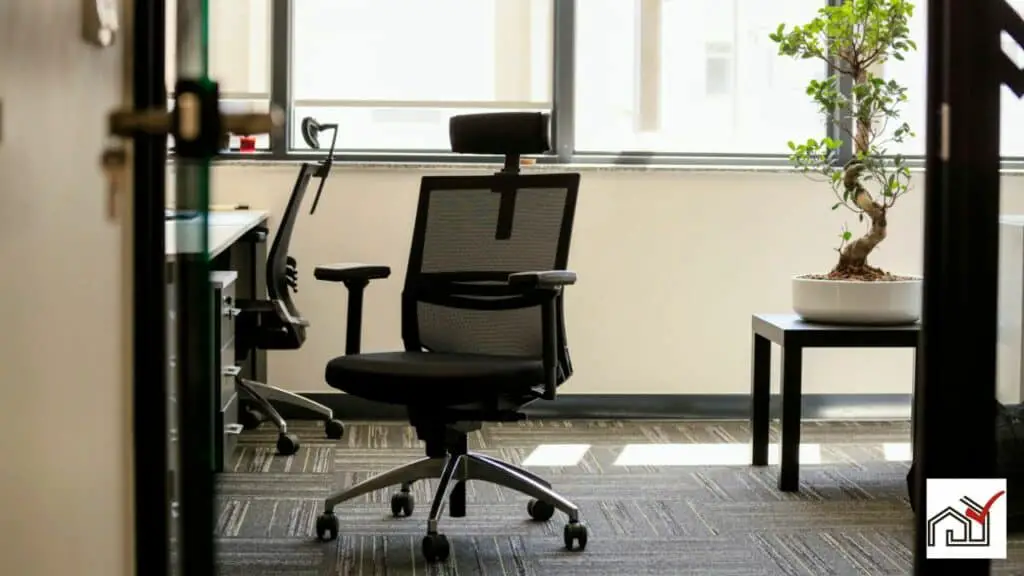To choose the right desk size, measure your workspace to ensure the desk fits and allows for easy movement.
Consider the desk's main use, such as computer work or handling paperwork, to decide on the needed surface area.
The desk height should match your posture and chair height to avoid discomfort.
Desks range from simple writing tables to large corner units, each suited for different needs.
Pick a desk that supports your work efficiently and fits well in your space.
Assessing Your Workspace
When choosing a desk, measure your workspace to ensure the desk fits and allows for easy movement. Measure the work surface needed for your tasks. If multiple monitors or large work areas are necessary, opt for a bigger desk. For smaller spaces, choose a compact design. Account for extra equipment like printers or organizers.
Desk widths typically range from 48 to 72 inches. Select a size based on your needs and office layout, ensuring room for drawers to open and leg space. A proper fit is essential for ergonomic comfort and increased productivity.
Calculating Desk Proportions
To find the right desk size, measure the width and depth of the space where it will be placed. This determines the maximum size possible for the desk. Ensure there is also enough space around the desk for easy movement.
Consider the work to be done on the desk. More monitors or paperwork require a larger desk, while simple tasks may need a smaller one. Account for extra items like lamps and organizers that need desk space.
Desk height is important for comfort and to prevent strain. Make sure the desk height matches the user's seated height, with enough space for the knees and within easy reach to prevent stretching.
The right desk size should suit the user's body and work needs for a better workspace.
Ergonomic Considerations
The size and shape of a desk must meet ergonomic standards to provide a comfortable and efficient workspace, affecting health and productivity. The typical desk height is between 28 and 30 inches to match the average person's seated elbow height, but individual adjustments are necessary to prevent wrist, arm, and shoulder strain.
Desk size should offer sufficient space for legs, feet, and chairs to move freely, which aids in circulation and reduces discomfort or injury risk. The desk surface should be large enough to hold a computer, paperwork, and other equipment without being overcrowded.
Standing desks are becoming more popular to combat sedentary lifestyles and should be adjustable for ergonomic benefits, allowing posture variation throughout the day to decrease the chances of developing musculoskeletal issues.
In choosing a desk, consider personal body measurements, the nature of the work, and the equipment used. An ergonomic desk can lead to a healthier workplace and increased productivity by minimizing fatigue and discomfort.
Investing in ergonomic furniture is beneficial for personal well-being and sustained work performance.
Desk Types and Functions
Choosing the right desk size requires understanding the different desk types and their purposes. Desks are designed for various needs in both office and home environments. A standard office desk typically provides space for a computer, phone, and documents.
When selecting a desk, consider the equipment you will use. A desk for two monitors will be wider than one for a single laptop. Computer desks often include features for cable management and storage for tech accessories, affecting the required desk size.
There are desks beyond those for computer use. Writing desks are simple and compact, suitable for tasks needing a clear workspace. Gaming desks are wider and stronger to accommodate multiple screens and equipment. Standing desks and adjustable models offer ergonomic advantages and come in sizes to match users' height and movement.
Drafting tables for design or architecture work can tilt and adjust, requiring space for large papers or blueprints. Executive desks are large, conveying authority and often taking up considerable space in an office.
Choosing the right desk size is crucial for productivity and comfort. By understanding the desk functions and types available, individuals can find a desk that fits their space and work needs.
Maximizing Desk Efficiency
To maximize desk efficiency, choose a desk that fits all necessary equipment and materials while allowing for easy access. A typical office desk is at least 30 inches wide, suitable for limited spaces or minimal needs.
Desk efficiency also depends on how the space is used. Adding storage solutions and organizers can improve the efficiency of a small desk. Vertical storage and organizing tools help maintain a tidy workspace.
For those needing more space, a larger desk can increase productivity by accommodating more documents, multiple monitors, and space for creative projects. Ensure the desk is sufficiently large but does not hinder the functionality of the surrounding area.
The objective is to choose a desk size that matches your work habits and fits the available space. Whether small or large, organizing your desk to complement your workflow is crucial for making the most of the space.





